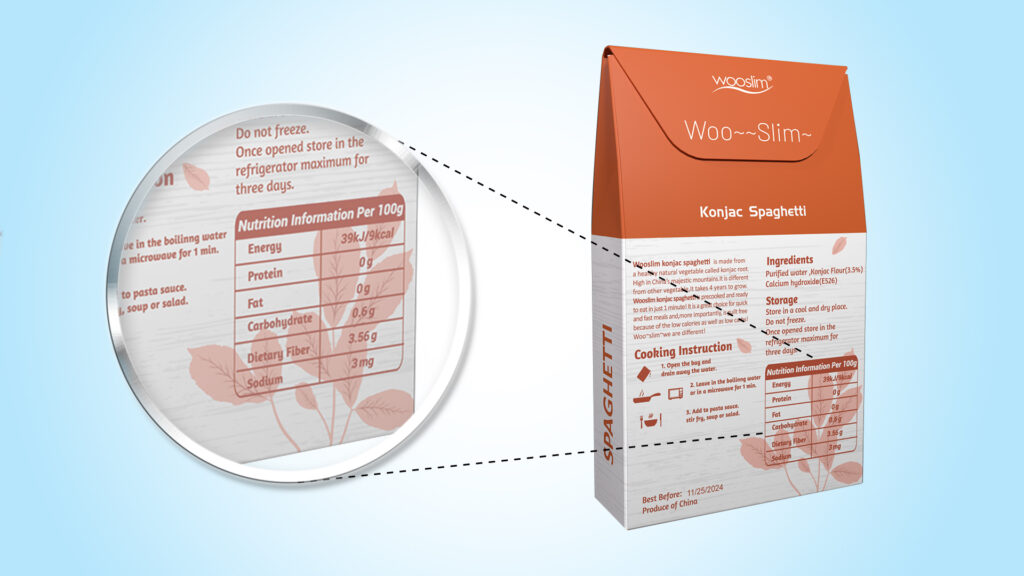
Contact Us through info@lovekonjac.com
If you’re on a ketogenic diet, you may be asking whether you should count the net carbs or the total carbohydrates. The keto diet restricts carb intake and replaces it with fat to achieve ketosis, a state where your body burns fat for energy.
If you want to know the answer or you’re interested in understanding how food labels work, this information about counting total carbs and net carbs will help you.

When you look at food labels, you’ll often see a value for total carbohydrates. Total carbs are essentially the total number of carbohydrates, this figure includes all the different types of carbohydrates present in the food, which encompasses:
– Starches (digestible complex carbohydrates)
– Sugar alcohols
– Plant fibers (indigestible complex carbohydrates)
Total carbohydrates are measured using an indirect subtraction method that relies on three other measurements, which means that each time you depend on more than one value, the inaccuracies start to build up, making total carbohydrates less accurate than one might assume.
On the other hand, fiber is measured directly using an enzymatic-gravimetric method. In this process, a food sample is treated with enzymes to mimic digestion in the small intestine, removing digestible carbohydrates. What remains is the non-digestible carbohydrates, which contains the fiber, protein and inorganic material called ash on most labs. The last two are subtracted from the weight to get the total dietary fiber. Like the measurement for total carbs, the measurement for fiber is also not as accurate as you think.

Net carbs represent the carbohydrates in food that the body can absorb and use for energy. To calculate net carbs, you subtract the fiber and sugar alcohol content from the total carbohydrates:
Net Carbs= Total Carbs – Fiber -Sugar Alcohol
Most fibers are not broken down by the human digestive system, so they don’t impact blood sugar levels. However, certain fibers can be fermented by gut bacteria, producing byproducts that serve as fuel for the lining of the intestines.
That’s why plant-based pastas like Shirataki Noodles act as a prebiotic fiber, which means they are digested by your gut microbiome to help it grow. Fiber here is being processed in a sense, but when it comes to blood sugar and people on ketogenic diets, it’s not going to have an effect.

When you check low carbohydrate foods like Konjac Noodles, you’ll see something interesting on the label: in many plain noodles, you’ll see taht the total carbohydrates are less than the total fiber. For instance, the label indicates two grams of fiber but only one gram of total carbohydrates. This may raise questions about how fiber, classified as a carbohydrate, can exceed total carbohydrates. Remember that you’re taking away the total fiber from the total carbohydrates to get the net carbs.
How can the total carbohydrates on a food label be less than the total fiber? This is because when you get to the very low levels of low-carb foods, the inaccuracies of the lab tests done to measure carbs and fiber start to reveal themselves.
This discrepancy arises because total carbohydrates and fiber are measured differently. The product is so dilute in terms of its carbohydrate and its fiber, even though there are two full grams of fiber in a serving, the product itself is 97% water. So, you’re getting these dilute measurements being done and you’re starting to see the inaccuracies mentioned above.
While these inaccuracies are generally minor, they can be significant for those using a ketogenic diet for medical reasons, such as managing seizures or cancer, you have to be careful because you’re dealing with inaccuracies of one or two grams in low-carb foods.It’s advisable to do blood tests at the very beginning to check if you’re in ketosis. Tools like Keto Mojo can quickly measure your blood ketones and glucose levels.
Many people on keto diets might find that despite eating foods labeled asketo-certified, their blood tests reveal they aren’t in ketosis. This can happen because the small inaccuracies in low-carb food labels add up. The next time you see low-carb keto diet-friendly foods that have one or zero net carbs, consider looking at the raw ingredients. Go to the USDA, EU Oganic, JAS website to check raw food ingredients. It tells you the carbohydrate and fiber content of the raw ingredient.
Know that you’re dealing with some inaccuracies and you’re probably getting one or two grams of some kind of carbohydrate, which are not reflected accurately on the food label.
When it comes to sugar alcohols, erythritol and xylitol are okay. While maltitol is not recommended. You also have to watch out for sucralose as it damages your gut microbiome. However, erythritol and xylitol typically do not affect blood sugar levels.
Remember that non-sugar sweeteners can also impair your ability to perceive natural sweetness, decreasing your ability to enjoy low-sugar foods like blueberries and blackberries. Over time, you may develop a preference for sweeter foods, making it harder to enjoy natural, less sweet options.
I hope this answers your questions about total carbs and net carbs. If you have more questions or need support, feel free to comment below~